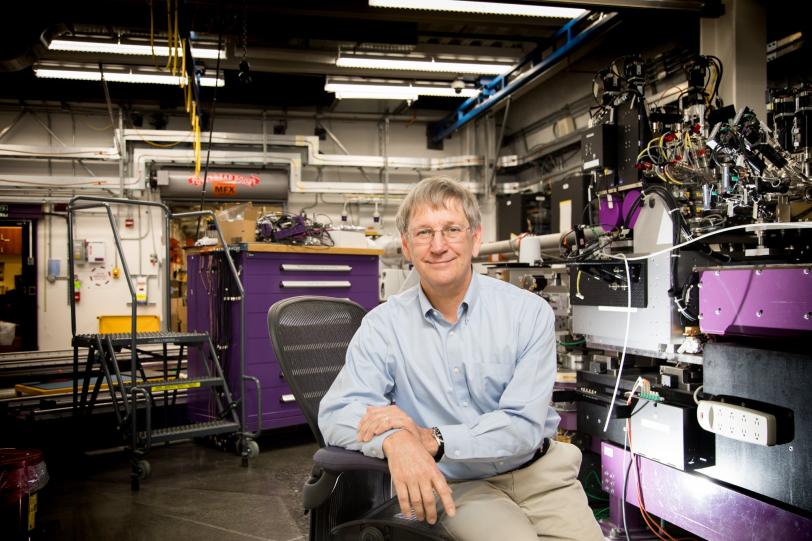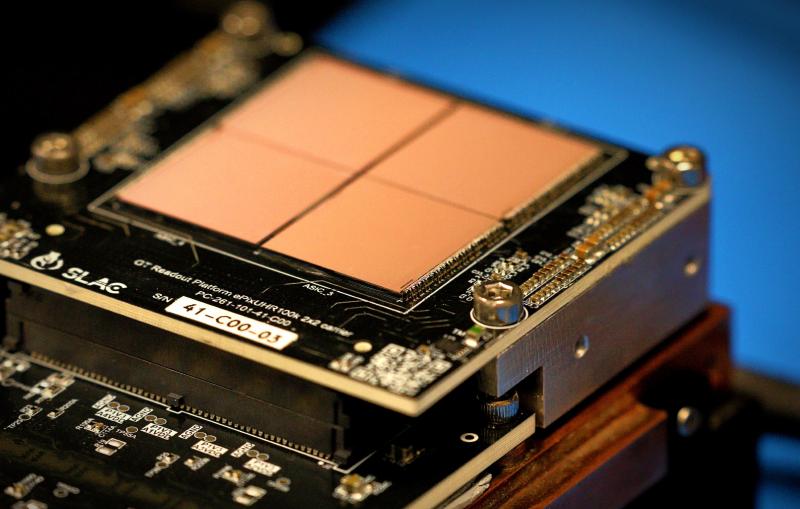Where Scientist Meets Machine: A Fresh Approach to Experimental Design at SLAC X-Ray Laser
Paul Fuoss’s Mission is to Make Experiments at LCLS and Other Light Sources More Productive and User-Friendly
By Glennda Chui
Big leaps in technology require big leaps in design – entirely new approaches that can take full advantage of everything the technology has to offer.
That’s the thinking behind a new initiative at the Department of Energy’s SLAC National Accelerator Laboratory. To make sure experimenters can get the most out of a major X-ray laser upgrade that will produce beams that are 10,000 times brighter and pulses up to a million times per second, the lab has created a new position – head of experimental design at the Linac Coherent Light Source – and hired a world-renowned X-ray scientist to fill it.
Paul Fuoss (pronounced “foos”) will look at LCLS and the LCLS-II upgrade from a fresh perspective and work with scientists and engineers across the lab to design instruments, user-friendly control systems and experimental flows that take full advantage of this technological leap.
Although the upgrade won’t be finished until the early 2020s, there’s really no time to lose, said LCLS Director Mike Dunne.
“We’re on the verge of a transformation of our science capabilities that is simply unattainable today. When you take these big leaps you have to fundamentally rethink how you approach the science and the design of experiments," Dunne said.
“You can’t just do it the way you did before but a bit better. You have to approach it from a completely new thought process: What is the scientific knowledge you’re trying to get out, and what is the scientific data that might illuminate that new understanding, and how does that translate back into how you obtain that data, and how does that influence how you design the facility?”
Taming Complexity to Make Science More Productive
For Fuoss, the broader goal is to increase productivity and improve the experiences of scientists at X-ray light sources everywhere.
“Experiments have gotten a lot more complex over the past 20 years, not just at LCLS but at synchrotron light sources, too,” he said. “We’ve gone from controlling experiments with a single computer and detecting a single pixel of data at a time to using multiple computers and detecting more like a million pixels at once. Our ability to integrate different tools and computers and visualize the data has often not kept up with the technology. And at LCLS, that complexity is going to increase dramatically in a few years when the LCLS-II upgrade becomes operational.”
One way to make working with LCLS more streamlined and intuitive is to incorporate user-friendly features into the instruments that come on board as part of LCLS-II.
“A lot of that will be working with the scientists and engineers who are designing those instruments to get the building blocks for user compatibility in there,” Fuoss said. “It’s not part of the core training of scientists and engineers, so we expect we will need to reach out to people who have that expertise and get them to help us.”
Another way, he said, is to create tools that let scientists visualize their data as it’s being collected, so they can understand what is going on in real time.
“There are a lot of different pieces that need to be coordinated,” Fuoss said. “All of them are currently being done, but we need to bring a unified focus and make sure there are no unnecessary barriers. Ultimately, you want to integrate this kind of thing into everyone’s day-to-day development activities.”
X-Rays, Inventions and Human Interfaces
Fuoss has deep roots at SLAC. Originally from South Dakota, where he grew up on a ranch, he earned a degree in physics at South Dakota School of Mines and Technology and came to Stanford University in 1975 for graduate school. He wound up doing his graduate research at SLAC, using X-rays from what later became the Stanford Synchrotron Radiation Lightsource (SSRL) to investigate materials.
After earning a PhD, Fuoss went on to do research at Bell Laboratories, AT&T Laboratories and Argonne National Laboratory. He’s been an active user of SSRL and other light sources and has developed a number of new techniques for exploring materials with X-rays, many of which are now standard at light sources around the world; in 2015 he received SLAC’s Farrel W. Lytle Award for this work. Fuoss also played a role in designing LCLS.
In the mid-1990s, while a researcher at AT&T Laboratories, Fuoss took a six-year detour into the world of human interface design and human factors research – the study of how people interact with technology, from airplane cockpits to your office copier. Back then, he focused on making telecommunications systems and web interfaces more user friendly. This experience can also be applied to LCLS experimental design.
“Paul has an incredible background,” Dunne said. “He brings that deep understanding of the nature of X-ray science, an understanding of all the instruments and the technical pieces, and then an understanding of what we’re trying to achieve scientifically.”
Getting the Most out of Beam Time
Unlike synchrotron light sources, which may have dozens of X-ray beamlines and many experiments going on simultaneously, the current version of LCLS has just one powerful beam, a billion times brighter than any available before, whose pulses arrive up to 120 times per second. In theory this limits the facility to doing one experiment at a time.
But in the seven years since it opened, scientists and engineers have come up with a number of ways to get around that limitation, such as splitting the beam so it can be delivered to two or more experiments at once. At the same time, they reduced the down time between experiments by scheduling similar experiments back to back, so they don’t have to change out equipment as often. These and other measures increased the number of experiments run per year by 72 percent from 2014 to 2016, and LCLS recently passed the milestone of hosting more than 1,000 users per year.
LCLS-II will add a second X-ray laser beam, further increasing the facility’s capacity. By continuing to find ways to squeeze in more experiments while making the way people interact with LCLS more straightforward, Fuoss said, “We can improve productivity and allow the scientific users to have a more hands-on role in the actual data collection. That will both reduce the load on the LCLS staff and lead to a better experience for the scientists who are coming here to use it.“
LCLS and SSRL are DOE Office of Science User Facilities.
Contact
For questions or comments, contact the SLAC Office of Communications at communications@slac.stanford.edu.
SLAC is a multi-program laboratory exploring frontier questions in photon science, astrophysics, particle physics and accelerator research. Located in Menlo Park, Calif., SLAC is operated by Stanford University for the U.S. Department of Energy's Office of Science.
SLAC National Accelerator Laboratory is supported by the Office of Science of the U.S. Department of Energy. The Office of Science is the single largest supporter of basic research in the physical sciences in the United States, and is working to address some of the most pressing challenges of our time. For more information, please visit science.energy.gov.






